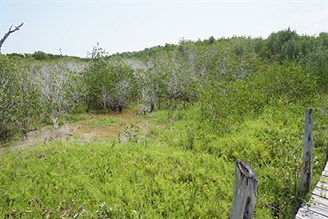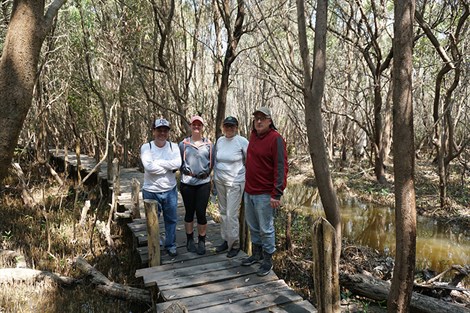 Mangroves are not only found in Mexico, but also along the coastline of other Gulf of Mexico provinces, particularly in Florida and the Caribbean, as well as within the rest of the equatorial belt around the world.
Mangroves are not only found in Mexico, but also along the coastline of other Gulf of Mexico provinces, particularly in Florida and the Caribbean, as well as within the rest of the equatorial belt around the world.
The critical role of a healthy mangrove on the local environment is trifold. They reduce coastal erosion by absorbing wave energy and stabilizing the soil, filter salt from the local surface water and are home to various wetland species. The main threats to these, and most mangroves around the world, are the results of human interaction through changes to land cover and pollution. Such an impact has been observed in the Rio Celestun Biosphere Reserve as groundwater reserves have been slowly diverted from their natural flow or depleted from over extraction, increasing stress on the local mangroves.
Currently, researchers at the Center for Research and Advanced Studies of the National Polytechnic Institute (CINVESTAV) are actively working to revive a stretch of mangroves along the western coast of Yucatan within the Rio Celestun Biosphere Reserve. Earlier this year, Dr. Zenon Medina-Cetina, and Natalie Zielinski, research assistant in Medina-Cetina's Stochastic Geomechanics Laboratory, and Dr. John Walewski traveled to Yucatan, Mexico, where they met with leading government representatives and scientists to discuss collaborative opportunities within research and the community.
Medina-Cetina is an associate professor in the Zachry Department of Civil Engineering with joint appointments in the Harold Vance Department of Petroleum Engineering and the Department of Ocean Engineering at Texas A&M University. The visit was conducted in alignment with Medina-Cetina’s Yucatan Initiative Project, which seeks to further develop Texas A&M’s research and academic relations within Mexico’s Yucatan peninsula.
 Texas A&M researchers were able to gain an up-close look at current mitigation operations in Celestun, beginning with a tour through the reserve to various sites of ongoing revival, a process that involves different phases from initial reestablishing of native wetland species to well-developed ecosystems. The impact of the revival process over the past decade is evident in the transformation of the land from dry wasteland to an abundant and thriving green haven.
Texas A&M researchers were able to gain an up-close look at current mitigation operations in Celestun, beginning with a tour through the reserve to various sites of ongoing revival, a process that involves different phases from initial reestablishing of native wetland species to well-developed ecosystems. The impact of the revival process over the past decade is evident in the transformation of the land from dry wasteland to an abundant and thriving green haven.
In Rio Celestun, researchers toured a site for the monitoring of biomass accumulation and ground water level. To catch the falling leaves and biomass, scientists have placed nets near the ground in order to estimate the rate of soil accumulation. Various pipes have also been driven into the ground to measure the level of water available for the mangroves.
As the work in Rio Celestun continues, the health of the mangroves and the understanding for their impact on the local communities improves. With threats, such as increased pressure on freshwater resources and land cover alteration for human use, the survival of the mangroves in a changing climate will remain an important research area on which local communities and governments depend for future mitigation and management of natural resources.
The Yucatan Initiative looks forward to the collaborative projects and efforts that are being developed within CINVESTAV and Texas A&M. Engaged faculty hope to further contribute to the body of knowledge on dynamic nature or mangroves and its restoration. To stay informed on these collaborations, visit their website.
Author: Rachel Holanda
Contributing author: Natalie Zielinski
Photo Credit: Anna Heller